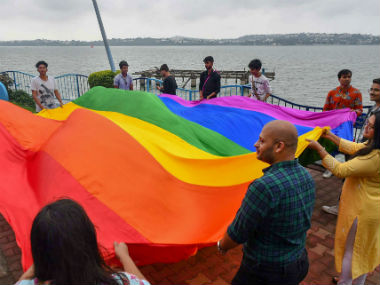In a landmark moment for the LGBTQ (lesbian, gay, bisexual, transgender, and queer) community,
the Supreme Court on Thursday decriminalised queer sexual orientation by partially scrapping the archaic Section 377 of the Indian Penal Code (IPC). [caption id=“attachment_5141671” align=“alignleft” width=“380”] Representational image. PTI[/caption] The colours of the rainbow dominated the scene with the iconic ‘rainbow flag’ that represents the community, taking all shapes and forms. The symbol is also called the ‘gay pride flag’. The most common variant of the rainbow flag consists of six stripes: red, orange, yellow, green, blue, and violet, and is usually in horizontal stripes. The flag signifies the LGTBQ community’s identity and is a symbol of solidarity. The rainbow symbolises togetherness and diversity.
According to a report by CNN, the flag represents the ‘all-inclusive’ idea and stands for all religion, race, gender, age, and nationality. Each colour in the flag hold meaning — violet is for spirit, blue is for peace, green is for nature, yellow is for sunlight, orange means healing and red is for life. The flag was designed by Gilbert Baker in 1978. In San Franciso, Baker was asked to design a flag for the community by Harvey Milk, the first openly gay US politician to be elected for an office in California. After the assassination of Milk in 1978, the flag became the symbol of queer pride. He chose eight colours for the flag with great care, each with symbolic meaning: Hot Pink: Sexuality Red: Life Orange: Healing Yellow: Sunlight Green: Nature Turquoise: Magic/Art Blue/Indigo: Serenity/Harmony Violet: Spirit However, he later removed pink and turquoise to make recreating the flag in bulk cheaper and easier. CNN quotes Baker in a 2015 article, when the US Supreme Court legalised same-sex marriages, as saying, “We needed something to express our joy, our beauty, our power. And the rainbow did that,” Baker says. “We’re an ancient, wonderful tribe of people. We picked something from nature. We picked something beautiful.” Until the rainbow flag in 1978, the community had been using the Nazi-given pink triangle symbol, which was at one point used to mark out gay, bisexual and transgender prisoners. It came to be used as a positive symbol in the 1970s when the newly active European and American gay liberation advocates began to use the pink triangle to raise awareness of its use in Nazi Germany. However, later on, members of the LGBTQ community felt the need to create a symbol just as empowering as the triangle had been, but without the checkered past.
Mental Floss reported that in 2003, Baker helped create the world’s biggest LGBTQ flag, spanning the length of around one and a half kilometres across the Gulf of Mexico to the Atlantic Ocean. Afterwards, sections of the flag were sent to more than 100 cities around the world.
Section 377 was partially scrapped in a landmark moment for the LGBTQ (lesbian, gay, bisexual, transgender, and queer) community, by the Supreme Court on Thursday.
Advertisement
End of Article


)

)
)
)
)
)
)
)
)



